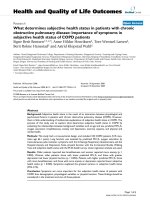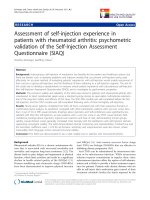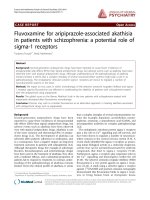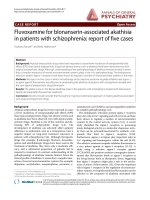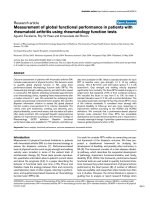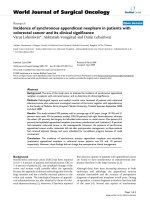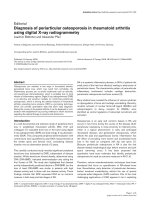Báo cáo y học: " Diagnosis of invasive bronchial-pulmonary aspergillosis in patients with chronic obstructive respiratory diseases" pptx
Bạn đang xem bản rút gọn của tài liệu. Xem và tải ngay bản đầy đủ của tài liệu tại đây (112.78 KB, 2 trang )
In the previous issue of Critical Care, we read with interest
the article by He and colleagues [1] on invasive bronchial-
pulmonary aspergillosis (IBPA) in critically ill patients
with
chronic obstructive respiratory diseases (CORDs).
In this prospective study, the authors, contrary to their
statement, did not follow the case defi nitions for ‘probable’
invasive pulmonary aspergillosis (IPA) as defi ned by the
consensus of the European Organization for Research
and Treatment of Cancer and the National Institute of
Allergy and Infectious Diseases Mycoses Study Group
(EORTC/MSG) [2]. Indeed, EORTC/MSG criteria for
probable IPA require that all three of the following
concomitant conditions be fulfi lled: presence of a host
factor, presence of a clinical criterion, and presence of a
mycological criterion. In the study group with IBPA, at
least two patients (patients 4 and 13) did not fulfi ll these
criteria and thus were erroneously incorporated in the
case group. Furthermore, only 4 patients (out of 13) had
histologically proven invasive bronchial aspergillosis, and
many patients thus may have been erroneously classifi ed
in the IBPA group since no autopsy was performed.
Considering the low number of patients with IBPA as
well as the misclassifi cation of some of them, we feel that
providing independent variables predicting IBPA (with
further extrapolation of a diagnostic algorithm) in
critically ill patients with CORD is irrelevant.
© 2010 BioMed Central Ltd
Diagnosis of invasive bronchial-pulmonary
aspergillosis in patients with chronic obstructive
respiratory diseases
Pierre Bulpa* and Alain Dive
See related research by He et al., />LETTER
Authors’ response
Hangyong He, Lin Ding, Fang Li and Qingyuan Zhan
We thank Bulpa and Dive for their comments. We agree
that some cases in our study did not strictly fulfi ll the
EORTC/MSG diagnostic criteria, mainly for a lack of
host factors. However, the EORTC/MSG criteria for IPA
were developed for patients with malignant disease and
recipients of allogeneic hematopoietic stem cell and
solid-organ transplants [2]. Owing to the absence of data,
the criteria do not apply to non-cancer populations. In
2007, Bulpa and colleagues [3] relied on several case
reports to propose their defi nitions of IPA, specifi cally
for chronic obstructive pulmonary disease patients and
isolation of Aspergillus. e diagnoses for 36 patients
(64%) were classifi ed as proven in their study, and this
circumstance confi rmed the validity of their criteria. As a
result, their criteria may be more appropriate for IPA in
future studies with the CORD population.
We agree that additional proven cases are needed to
avoid the misclassifi cation of some patients with IBPA.
However, invasive procedures such as transbronchial
biopsies are rarely performed in late-stage critically ill
patients with CORD, and this dramatically limits the
possibility of collecting histological evidence of IPA. In a
recent study with the largest series of IPA in patients with
chronic obstructive pulmonary disease, none of the 53
cases had a lung biopsy [4]. e biopsy of bronchial
mucous is less invasive and may give evidence of trachea-
bronchial invasion with Aspergillus. erefore, we prefer
to do bronchial mucous biopsy rather than transbronchial
lung biopsy under bronchoscopy for an early diagnosis of
IBPA in patients with CORD.
Abbreviations
CORD, chronic obstructive respiratory disease; EORTC/MSG, European
Organization for Research and Treatment of Cancer/National Institute of
Allergy and Infectious Diseases Mycoses Study Group; IBPA, invasive bronchial-
pulmonary aspergillosis; IPA, invasive pulmonary aspergillosis.
Competing interests
The authors declare that they have no competing interests.
*Correspondence:
Intensive Care Unit, Mont-Godinne University Hospital, Université Catholique de
Louvain, Avenue Therasse 1, 5530 Yvoir, Belgium
Bulpa and Dive Critical Care 2011, 15:420
/>© 2011 BioMed Central Ltd
Published: 27 April 2011
References
1. He H, Ding L, Li F, Zhan Q: Clinical features of invasive bronchial-pulmonary
aspergillosis in critically ill patients with chronic obstructive respiratory
diseases: a prospective study. Crit Care 2011, 15:R5.
2. De Pauw B, Walsh TJ, Donnelly JP, Stevens DA, Edwards JE, Calandra T, Pappas
PG, Maertens J, Lortholary O, Kau man CA, Denning DW, Patterson TF,
Maschmeyer G, Bille J, Dismukes WE, Herbrecht R, Hope WW, Kibbler CC,
Kullberg BJ, Marr KA, Muñoz P, Odds FC, Perfect JR, Restrepo A, Ruhnke M,
Segal BH, Sobel JD, Sorrell TC, Viscoli C, Wingard JR, et al.: Revised de nitions
of invasive fungal disease from the European Organization for Research
and Treatment of Cancer/Invasive Fungal Infections Cooperative Group
and the National Institute of Allergy and Infectious Diseases Mycoses
Study Group (EORTC/MSG) Consensus Group. Clin Infect Dis 2008,
46:1813-1821.
3. Bulpa P, Dive A, Sibille Y: Invasive pulmonary aspergillosis in patients with
chronic obstructive pulmonary disease. Eur Respir J 2007, 30:782-800.
4. Guinea J, Torres-Narbona M, Gijón P, Muñoz P, Pozo F, Peláez T, de Miguel J,
Bouza E: Pulmonary aspergillosis in patients with chronic obstructive
pulmonary disease: incidence, risk factors, and outcome. Clin Microbiol
Infect 2010, 16:870-877.
doi:10.1186/cc10138
Cite this article as: Bulpa P, Dive A: Diagnosis of invasive bronchial-
pulmonary aspergillosis in patients with chronic obstructive respiratory
diseases. Critical Care 2011, 15:420.
Bulpa and Dive Critical Care 2011, 15:420
/>Page 2 of 2



